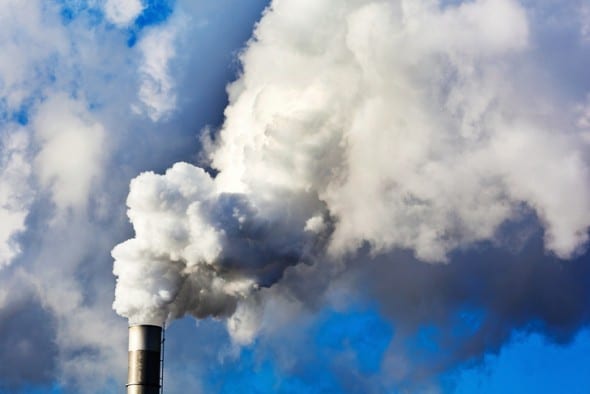One week shy of UN climate talks in Paris, a new report has warned that Australia will fall well short of achieving any “real” emissions reductions under its current climate policy, but instead would grow its national emissions by a huge 6 per cent, from around minus 2 per cent on 2000 levels today, to 4 per cent above 2000 levels by 2020.
The report, released on Monday by energy market analysts RepuTex, says the only way Australia will meet its international commitment to cut emissions by 5 per cent on 2000 levels will be via the “accounting benefit” gained through the Kyoto Protocol.
The report also warns that the projected increases in real emissions over 2015-20 will come at a cost, doubling the rate of Australia’s annual abatement task out to 2030.
“While emissions are increasing, we continue to anticipate that the government will utilise more than 130 million carry-over credits under Kyoto, which will give us a large accounting buffer to meet our 2020 target” said Hugh Grossman, Executive Director of RepuTex.
“While we will meet our international commitment, Australia’s absolute emissions will not reach minus 5 per cent on 2000 levels”
“We project real emissions will increase to plus 4 per cent on 2000 levels by 2020, or 6 per cent from today, despite current government policy” he said.
The report comes after the release of the results from the second ERF auction, which contracted for 45 million Australian Carbon Credit Units (ACCUs) to be delivered over 10 years, spending $550 million.
After two auctions – or one year of the scheme – the ERF has contracted 93 million ACCUs, committing $1.2 billion, allocated to 131 projects. This will be supplied over approximately 10 years, an average of 9.3 million per year.
And while Australia will be able to increase its emissions and still meet its 2020 target, analysis indicates that allowing emissions to grow will place significant pressure on Australia’s 2030 abatement task, potentially more than doubling the amount of annual abatement required to meet Australia’s long-term target.
“Unfortunately, current policy can’t keep up with emissions increases. While the ERF has been successful, the rate of annual Australian emissions growth is significantly outpacing any emissions reductions contracted under the scheme,” said RepuTex executive director Hugh Grossman.
“After two auctions, the ERF will supply an average of 9.3 million ACCUs per year prior to 2020, but emissions will grow 43 million tonnes per year over the same period”
According to RepuTex, the surge in Australia’s emissions growth is largely a result of increasing economic output from emissions intensive activities, even accounting for a slowdown in commodity prices.
“Australia is set to experience a period of emissions growth,” Grossman said. “Emissions have increased 2 per cent in the electricity sector over the past year, and coal will continue to dominate the fuel mix in the short-term.”
“In addition, we will see new and expanding Coal and LNG facilities come online over the next five years, plus growing demand for coal in Asia. So given the growing rate of output, domestic emissions are set to increase, despite the ERF”
“As new facilities come online, emissions will follow. You can’t have one without the other.
The good news, however, is that RepuTex’s forecast for emissions growth of 6 per cent over the next five years is more favourable for the government than its own official figures. The Department of Environment forecast that emissions will increase by 20 per cent over the same period.
Much of this is driven by activity in the resources sector, with Australia’s thermal coal exports forecast to rise 11 percent to 223 million tonnes between 2014 and 2020, according to the Department of Industry.
In addition, new LNG facilities under construction such as Gorgon, Wheatstone, and APLNG are set to become operational in 2016, while new coal mines including Maules Creek, Grosvenor, and Eagle Downs will further increase emissions over 2015 to 2017.
“If emissions increase from today, that growth will need to be made up for later, which will place pressure on policy, and invariably industry, to find more cuts each year,” said Grossman.
“It is more efficient to generate cuts from today’s levels, rather than let any gains be unwound, and then pay to start over again later. By that point the market will have less time to reduce more emissions.”
The government will undertake a review of its Direct Action Plan policy in June 2017, reporting by November 2017. Any policy amendments are expected to take effect by 2018-19, at the earliest, in almost two to three years’ time.
According to RepuTex, the review timeline, combined with the dwindling ERF budget, may place pressure on the government to explore an interim policy.
“That may place pressure on the government to explore an interim policy prior to the 2016 federal election, such as more ERF funding, or the scale up of voluntary “early market” rules, to incentivise new projects, particularly from high emitting companies,” he said.
The Paris climate conference will run from November 30 to December 11, with Prime Minister Malcom Turnbull to attend the first day of the conference.
RepuTex is Australia’s largest provider energy and emissions market analysis, with customers at over 150 power, energy, metals, mining, land-use, waste, financials and government agencies.










